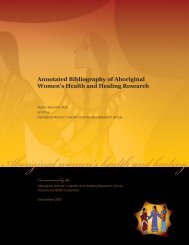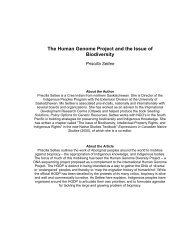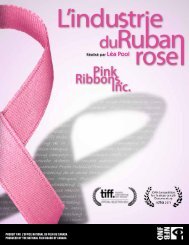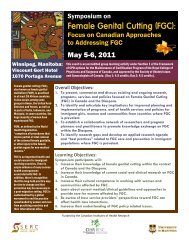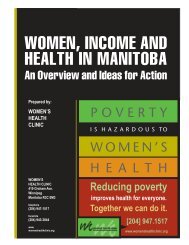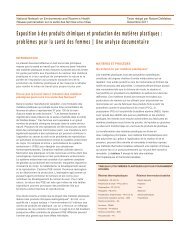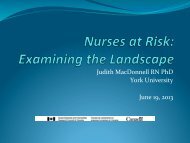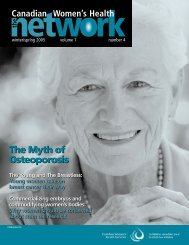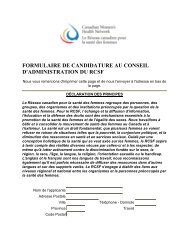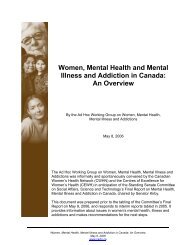NETWORK WIN00 - Canadian Women's Health Network
NETWORK WIN00 - Canadian Women's Health Network
NETWORK WIN00 - Canadian Women's Health Network
Create successful ePaper yourself
Turn your PDF publications into a flip-book with our unique Google optimized e-Paper software.
WHAT WE’RE READING & WATCHING recommended resources from our library<br />
From Barbara Bourrier-LaCroix, Information Centre Coordinator<br />
Surviving on Hope is Not Enough: Women’s <strong>Health</strong>, Poverty, Justice and<br />
Income Support in Manitoba<br />
Rhonda Wiebe and Paula Keirstead (Prairie Women’s <strong>Health</strong> Centre of Excellence, 2004)<br />
Available online at www.cewh-cesf.ca/PDF/pwhce/survivingOnHope.pdf<br />
Large print: www.cewh-cesf.ca/PDF/pwhce/survivingOnHopeLP.pdf<br />
If you are poor you are likely to experience more illness and have a shorter life expectancy<br />
than someone with a higher income. Women, especially women with disabilities,<br />
Aboriginal women and single mothers are more likely than men to live in poverty. Do publicly<br />
funded income support programs reduce poverty and improve health? How do<br />
women who rely on these programs experience them? The authors try to answer these<br />
questions by examining women’s experiences with these programs as well as their access<br />
to the justice system. The authors’ recommendations for change are based on the experiences<br />
of the women they interviewed and will be of particular interest to community<br />
workers and activists.<br />
Women, Peace and Security<br />
Sheri Gibbings (<strong>Canadian</strong> Research<br />
Institute for the Advancement of<br />
Women, 2004)<br />
Since September 11, 2001, national security<br />
has been defined in terms of the threat<br />
posed by terrorism. But who and what are<br />
genuine threats to our security? The<br />
<strong>Canadian</strong> government has responded to<br />
these perceived threats by spending more on<br />
defence, diverting money away from important<br />
social programs, making life more difficult<br />
for the poor. The authors of this fact<br />
sheet make the case that women are at particular<br />
risk. They are more likely to experience<br />
poverty, and the chauvinistic and violent culture<br />
that is often allowed to flourish in the<br />
military, leading to increased attacks on<br />
women as well as on visible minorities or<br />
racialized groups.<br />
First Stage Trauma Treatment: A Guide<br />
for Mental <strong>Health</strong> Professionals Working<br />
with Women<br />
Lori Haskell (Centre for Addiction and<br />
Mental <strong>Health</strong>, 2003)<br />
Many women seeking treatment for depression,<br />
chronic anxiety, substance-use problems,<br />
difficult or abusive relationships and self-inflicted<br />
harm are actually experiencing complex<br />
post-traumatic stress responses associated with<br />
chronic abuse and neglect in childhood. While<br />
mental health professionals may be aware of<br />
their clients’ early histories, they may underestimate<br />
the role of the trauma as the origin of<br />
their symptoms and fail to provide these<br />
women with the treatment they need. This<br />
guidebook has been developed to assist mental<br />
health workers and caregivers in understanding<br />
more about the impact of abuse and neglect in<br />
women’s lives. The author outlines the basic<br />
components of first stage trauma treatment<br />
and offers specific tools and concrete strategies<br />
to use in beginning this difficult work.<br />
<strong>Health</strong> Literacy: A Prescription<br />
to End Confusion<br />
(Institute of Medicine of the National<br />
Academies, 2004)<br />
<strong>Health</strong> literacy defines the degree to which<br />
individuals obtain, process and understand<br />
the information needed to make appropriate<br />
health decisions. It is essential to successful<br />
health care. As patients we convey our symptoms<br />
and medical history to health professionals<br />
who then convey back results, recommendations,<br />
information and instructions.<br />
But what if you don’t understand what’s<br />
being said to you? This report looks at the<br />
problems associated with low levels of<br />
health literacy, and recommends actions to<br />
promote a health-literate society. While written<br />
for an American audience, many, if not<br />
all, of the recommendations can be adapted<br />
for a <strong>Canadian</strong> perspective.<br />
My Body, My Responsibility: A <strong>Health</strong><br />
Education Video for Deaf Women<br />
(University of Rochester, 2003) 62 minutes<br />
There is a serious need for educational materials<br />
on reproductive health and this video<br />
helps fill that gap. It covers topics including<br />
puberty, menstruation, pregnancy and labour,<br />
birth control methods, and sexually transmitted<br />
diseases including HIV, and how to be<br />
tested for HIV. The film features deaf actresses<br />
in most roles and dialogue in American<br />
Sign Language throughout. It also has a spoken<br />
English voice-over and open captions<br />
(subtitles), so the film is accessible to hearing<br />
and hard-of-hearing people as well as sign<br />
language users.<br />
Is It Safe for My Baby? Risks and<br />
Recommendations for the Use of<br />
Medication, Alcohol, Tobacco and<br />
Other Drugs During Pregnancy<br />
and Breastfeeding<br />
(Centre for Addiction and Mental <strong>Health</strong>,<br />
2003)<br />
This booklet is for women who are planning<br />
a pregnancy, who are pregnant or breastfeeding.<br />
It gives information about the relative<br />
risks and safety to the fetus of prescription,<br />
over-the-counter and illegal drugs,<br />
along with alcohol, tobacco and other substances<br />
when the mother is pregnant, and to<br />
the baby, when breastfeeding. While the<br />
Women Need Safe, Stable, Affordable Housing: A Study of Social,<br />
Private and Co-op Housing in Winnipeg<br />
Molly McCracken and Gail Watson<br />
(Prairie Women’s <strong>Health</strong> Centre of Excellence, 2004)<br />
Available online at www.cewh-cesf.ca/PDF/pwhce/housing.pdf<br />
One in five <strong>Canadian</strong> women live in poverty. These women are at greater risk of living in<br />
unsafe and unhealthy environments and need support to achieve stable and affordable<br />
housing. This study looks at the effects of different housing policies on the economic<br />
security, health and well being of women in Winnipeg. Governments, policy-makers and<br />
community leaders can use the findings to learn which housing models and practices<br />
better meet women’s needs.<br />
16 WINTER/SPRING 2005 CWHN <strong>NETWORK</strong>




